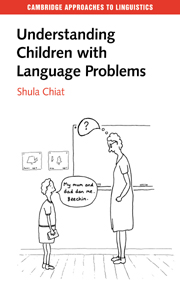Book contents
- Frontmatter
- Contents
- Acknowledgements
- Glossary of text conventions and symbols
- Introduction
- Part I Problems with words
- 1 What's in a word?
- 2 The child's road to words
- 3 Blocks on the road to words
- 4 Exploring the blockage
- 5 ‘Dant always day dings’: problems with phonology
- 6 ‘Stip’ or ‘step’ or ‘slip’ or what?: problems with lexical processing
- Part II Grappling with verb structure
- Part III Missing function morphemes
- Part IV Hidden meanings, baffling meanings
- Endpoint and springboard
- Further reading
- References
- Index
3 - Blocks on the road to words
Published online by Cambridge University Press: 05 September 2012
- Frontmatter
- Contents
- Acknowledgements
- Glossary of text conventions and symbols
- Introduction
- Part I Problems with words
- 1 What's in a word?
- 2 The child's road to words
- 3 Blocks on the road to words
- 4 Exploring the blockage
- 5 ‘Dant always day dings’: problems with phonology
- 6 ‘Stip’ or ‘step’ or ‘slip’ or what?: problems with lexical processing
- Part II Grappling with verb structure
- Part III Missing function morphemes
- Part IV Hidden meanings, baffling meanings
- Endpoint and springboard
- Further reading
- References
- Index
Summary
What of children who are not developing language normally? For such children, words are in some way a problem. They do not come to understand and produce words as rapidly or reliably as their normally developing peers.
Their difficulties may show up in tests of word comprehension such as the British Picture Vocabulary Scales (Dunn, Dunn, Whetton&Pintilie 1982) or Peabody Picture Vocabulary Test (Dunn&Dunn 1981). These tests present the child with a set of pictures from which she must select the one which matches the word that she hears. A child of 5 who makes the number of correct choices typically made by a 3-year-old demonstrates a problem with understanding words. Similarly, a child may perform at a level lower than expected on a test of word production, such as the Word-finding Vocabulary Scale (Renfrew 1980) or Test of Word Finding (German 1986). Some children may be up to the mark on tests of word comprehension and production, but fall down on an assessment of the way they say words, for example on the Edinburgh Articulation Test (Anthony, Bogle, Ingram & McIsaac 1971). They may also score below par on a test such as Wepman's Auditory Discrimination Test (Wepman&Reynolds 1987), in which they have to tell similar-sounding words apart. Shortfalls in any of these formal tests suggest the child has some sort of difficulty with words, and may also suggest what sort of difficulty. (For further examples and details of such clinical assessments, see Lees&Urwin 1997, Stackhouse&Wells 1997.)
Difficulties with words are also revealed in experiments where children are taught new words and subsequently tested on their comprehension or production of the words.
- Type
- Chapter
- Information
- Understanding Children with Language Problems , pp. 33 - 39Publisher: Cambridge University PressPrint publication year: 2000

